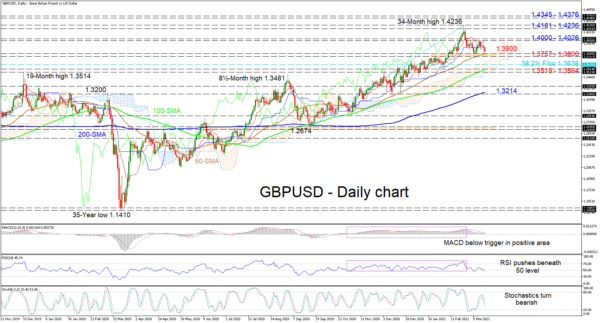GBPUSD is heading for a retest of the 50-day simple moving average (SMA), currently residing within a support base of 1.3757-1.3800. However, the soaring SMAs are defending the more than 5-month uptrend. The flattening red Tenkan-sen line, although beneath the rising blue Kijun-sen line – which is backing the positive picture – is suggesting that the bears may struggle to shift the momentum to the downside.
Nevertheless, the now bearish short-term oscillators are signalling that the endured bullish tone has faded. The MACD, in the positive region, is below its red trigger line and is aiming for the zero threshold, while the falling RSI is dipping into bearish territory. Furthermore, the negatively charged stochastic oscillator is promoting additional deterioration in the pair.
In the negative scenario, immediate hardened support may stem from the region of 1.3757-1.3800. Yet, should the recent consolidation in price dip below this key border, the bears could tackle the Ichimoku cloud before meeting the 1.3638 level, which happens to be the 38.2% Fibonacci retracement of the up leg from 1.2674 to the 34-month high of 1.4236. Managing to drive the price lower, sellers may then put pressure on the 1.3519-1.3564 limiting section, containing the 100-day SMA.
Otherwise, if the support base provides a foothold, buyers could face initial upside friction from the red Tenkan-sen line at 1.3900 ahead of the resistance band of 1.4000-1.4026. Conquering this vital barrier, could provide the necessary confidence for the bulls to challenge the next resistance zone located between 1.4181 and 1.4236, the latter being the multi-year peak. Triumphing above this, buyers may propel towards the 1.4345-1.4376 resistance belt.
Summarizing, GBPUSD is sustaining a bullish bias above the 1.3757-1.3800 region and the SMAs. A dive beneath the 100-day SMA could damage the positive structure.















